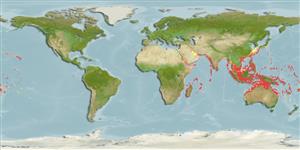>
Eupercaria/misc (Various families in series Eupercaria) >
Lutjanidae (Snappers) > Lutjaninae
Etymology: Macolor: Latin, macula, -ae = stain, spot.
More on author: Forsskål.
Environment: milieu / climate zone / ລະດັບຄວາມເລິກ / distribution range
ນິເວດວິທະຍາ
ສັດທະເລ ກ່ຽວກັນຫີນ; ລະດັບຄວາມເລິກ 2 - 90 m (Ref. 9821). Tropical; 36°N - 30°S, 31°E - 153°W (Ref. 55)
Indo-Pacific: East Africa to Samoa, north to central Japan, south to Australia.
ຂະໜາດ / ນ້ຳໜັກ / Age
ການຈະເລີນເຕັມໄວ: Lm ? range ? - ? cm
Max length : 75.0 cm TL ຕົວຜູ້/ບໍ່ມີເພດ; (Ref. 5484); common length : 35.0 cm TL ຕົວຜູ້/ບໍ່ມີເພດ; (Ref. 30573)
ຄີ (ໜາມ)ແຂງຢູ່ຫຼັງປາ (ທັງໝົດ) : 10; ຄີຫຼັງຂອງປາ (ຄີອ່ອນ) (ທັງໝົດ) : 13 - 15; ຄີ(ໜາມ) ແຂງຢູ່ຄີກົ້ນປາ
ກຸ່ມປາກະດູກແຂງ
ຄວາມຖີ່ຂອງກຸ່ມຖ່າຍທອດພັນ
ປາທີ່ມີການເຄື່ອນຍ້າຍຈາກທະເລໄປຫານ້ຳຈືດ ແລະນ້ຳຈືດຫາທະເລ
ປາທີ່ມີການເຄື່ອນຍ້າຍຈາກທະເລແລະໄປໄຂ່ຢູ່ນ້ຳຈືດ
ຄີກົ້ນຂອງປາ
ສັດທີ່ມີກະດູກສັນຫັຼງ
ການຖ່າຍທອດທາງກຳມະພັນຈາກພໍ່ແມ່ຫາລູກ: 3; ຄີກົ້ນຂອງປາ: 10 - 11. This species is distinguished by the following characters: body relatively deep and laterally compressed, greatest body depth 2.2-2.4 in SL; dorsal profile of head convex in adults, in oblique straight line in young; maxilla without scales or longitudinal ridges; preopercle with a deep notch (or gash) receiving elongate interopercular spine (none for individuals less than 16 cm SL); gill rakers of first gill arch 26-38 + 60-71 = 89-107; soft rays of dorsal fin usually 14, in anal fin 11, in pectoral fin 17; continuous dorsal fin with spinous portion distinctly notched in young; dorsal and anal fins distinctly pointed posteriorly, the soft ray of both fins, shorter than next to last ray; caudal fin rounded with middle rays elongated in small juveniles, slightly notched at intermediate sizes and emarginate in adults; pelvic fins short and rounded for all sizes; soft dorsal and anal fins with scales basally; tubed lateral-line scales 50-55; juveniles with very long pelvic fins. Colour of adults silvery grey, strongly blotched with blackish patches, lacks yellow on head and body and without blue markings on head and body, much duller iris; juveniles with black and white pattern but broader white area encompassing posterior head and adjacent body and with less than 5 white spots on back (Ref 9821, 90102).
Body shape (shape guide): fusiform / normal; Cross section: compressed.
Adults are found on steep outer walls of lagoon, channel and seaward slopes in large schools (Ref. 9710, 48635). Juveniles are solitary (Ref. 30573). Feeds largely on fishes and crustaceans Caught with handlines, gill nets, and traps, but also speared by divers and are frequently seen in markets and sold mainly fresh (Ref. 9821).
Life cycle and mating behavior
ການຈະເລີນເຕັມໄວ | ການສືບພັນ | ການວາງໄຂ່ | ໄຂ່ | ຄວາມດົກຂອງໄຂ່ປາ | ຕົວອ່ອນ
Allen, G.R., 1985. FAO Species Catalogue. Vol. 6. Snappers of the world. An annotated and illustrated catalogue of lutjanid species known to date. FAO Fish. Synop. 125(6):208 p. Rome: FAO. (Ref. 55)
IUCN Red List Status (Ref. 130435: Version 2025-1)
Threat to humans
Harmless
Human uses
ການປະມົງ: ເປັນສີນຄ້າ; ຊະນິດປາທີ່ຖືກນຳໃຊ້ເຂົ້າໃນການຫາເພື່ອເປັນເກມກິລາ: ແມ່ນ; ຕູ້ປາ: ເປັນສີນຄ້າ
ເຄື່ອງມື
Special reports
Download XML
ແຫຼ່ງອີນເຕີເນັດ
Estimates based on models
Preferred temperature (ເອກະສານອ້າງອີງ
123201): 24.7 - 29.1, mean 28.1 °C (based on 1828 cells).
Phylogenetic diversity index (ເອກະສານອ້າງອີງ
82804): PD
50 = 0.7500 [Uniqueness, from 0.5 = low to 2.0 = high].
Bayesian length-weight: a=0.01585 (0.00969 - 0.02592), b=3.00 (2.87 - 3.13), in cm total length, based on LWR estimates for this species & (Sub)family-body (Ref.
93245).
ຊັ້ນເຂດຮ້ອນ (ເອກະສານອ້າງອີງ
69278): 4.0 ±0.66 se; based on food items.
ຄວາມຢືດຢຸ່ນ (ເອກະສານອ້າງອີງ
120179): ຕຳ່, ປະຊາກອນຕຳ່ສຸດທີ່ໃຊ້ເວລາສອງເທົ່າ 4.5 - 14 ປີ (Preliminary K or Fecundity.).
Fishing Vulnerability (Ref.
59153): Moderate to high vulnerability (50 of 100).
🛈
Nutrients (Ref.
124155): Calcium = 25.8 [15.4, 46.1] mg/100g; Iron = 0.457 [0.254, 0.787] mg/100g; Protein = 19.1 [17.3, 20.8] %; Omega3 = 0.139 [0.095, 0.212] g/100g; Selenium = 40.8 [25.5, 69.5] μg/100g; VitaminA = 66.4 [23.9, 200.7] μg/100g; Zinc = 0.869 [0.629, 1.211] mg/100g (wet weight);
